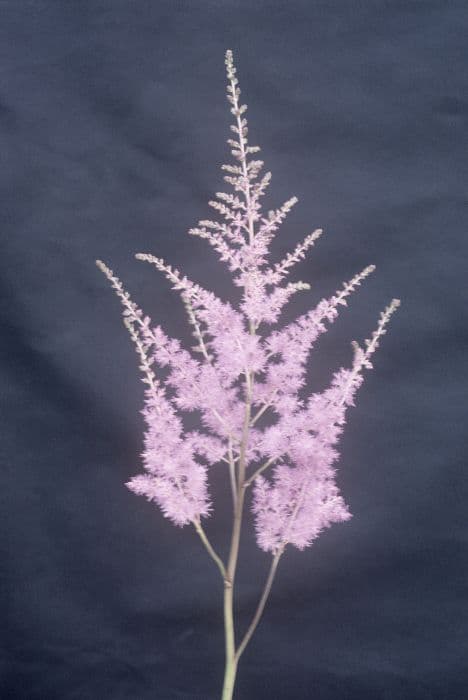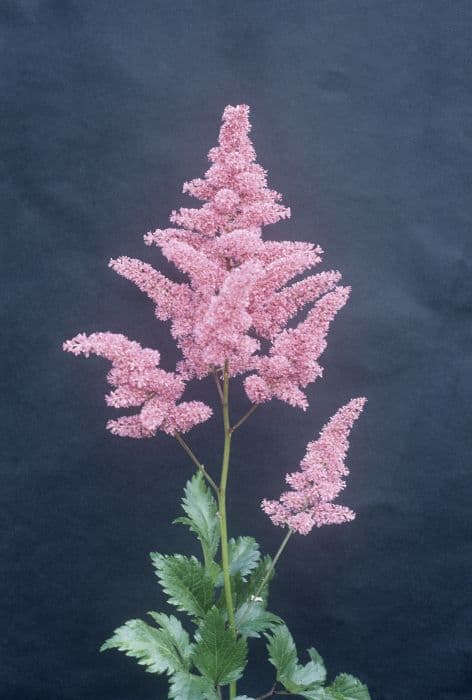Pigsqueak Bergenia 'Apple Blossom'

ABOUT
The Bergenia 'Apple Blossom', commonly known as Apple Blossom, is a striking perennial plant that is primarily grown for its lush foliage and lovely blossoms. It has large, leathery leaves that are typically glossy, contributing to its visual interest throughout the year. The leaves may change color with the seasons, often turning to bronzy hues or reddish tones during colder months, adding to its charm and seasonal appeal. Come spring, the Apple Blossom Bergenia produces clusters of delicate flowers atop stout stems, resembling clusters of apple blossoms, as suggested by its name. These flowers are generally light pink to white in color, providing a soft contrast to the bold foliage below. The blooms are attractive to pollinators such as bees and butterflies, making this plant not only a beautiful addition to the garden but also beneficial for local wildlife. The plant's foliage often forms a clump, which gives it a dense and robust presence. Its evergreen nature ensures that it maintains interest even when not in bloom. The Apple Blossom Bergenia is a versatile garden plant, used in borders, as ground cover, or even in container gardens, where its distinct foliage and floriferous nature can be showcased. The textured leaves coupled with the elegant flowers make it a popular choice for gardeners seeking both aesthetic appeal and low maintenance in their garden design.
About this plant
 Names
NamesFamily
Saxifragaceae
Synonyms
Pigsqueak, Elephant's Ears, Heartleaf Bergenia, Leather Bergenia
Common names
Bergenia ciliata 'Apple Blossom'.
 Toxicity
ToxicityTo humans
Bergenia 'Apple Blossom' is not commonly listed as a toxic plant for humans. Nonetheless, if a person ingests large amounts of any plant there might be a risk of gastrointestinal discomfort or other mild symptoms due to the unusual plant compounds. It's always best to err on the side of caution and not eat plants that are not typically recognized as food sources. If you suspect poisoning from any plant material, you should contact a medical professional.
To pets
For pets, the Bergenia 'Apple Blossom', also simply known as Bergenia, is generally not considered highly toxic. However, like with humans, the ingestion of plant parts in pets could possibly result in gastrointestinal upset such as vomiting or diarrhea. If a pet exhibits these symptoms after consuming Bergenia, it is wise to consult with a veterinarian for appropriate advice and treatment.
 Characteristics
CharacteristicsLife cycle
Perennials
Foliage type
Evergreen
Color of leaves
Green
Flower color
Pink
Height
1-1.5 feet (30-45 cm)
Spread
1-1.5 feet (30-45 cm)
Plant type
Herb
Hardiness zones
3
Native area
Asia
Benefits
 General Benefits
General Benefits- Easy to Grow: Bergenia 'Apple Blossom' is known for its low maintenance needs, making it ideal for beginner gardeners.
- Drought Tolerant: Once established, it has good resistance to periods of dry weather, reducing the need for frequent watering.
- Cold Hardy: It can survive and thrive in cold climates, withstanding temperatures typical of winter conditions.
- Attracts Pollinators: The flowers of the Bergenia 'Apple Blossom' attract bees and butterflies, supporting local ecosystems.
- Seasonal Interest: This plant offers year-round interest with its pinkish-white blossoms in spring and often evergreen leaves.
- Groundcover: Its thick foliage provides excellent ground cover, which can help prevent weed growth and soil erosion.
- Ornamental Value: Bergenia 'Apple Blossom' adds aesthetic appeal to gardens with its attractive flowers and foliage.
- Versatile Landscape Use: It can be used in a variety of landscape situations including borders, rock gardens, and as underplanting for taller shrubs.
 Medical Properties
Medical Properties- This plant is not used for medical purposes.
 Air-purifying Qualities
Air-purifying QualitiesThis plant is not specifically known for air purifying qualities.
 Other Uses
Other Uses- Bergenia 'Apple Blossom' can be used as a natural dye, producing subtle shades of pink and green depending on the mordant used.
- This plant's large leaves can serve as impromptu waterproof wrappers or covers for small outdoor items during unexpected rain showers.
- The leaves can be used creatively in crafts, such as natural stamps for paint or ink to create unique patterns on fabric or paper.
- Dried Bergenia leaves can be incorporated into homemade potpourri mixes for a touch of natural texture and subtle earthy scent.
- The thick leaves can be used as bookmark substitutes that will not only mark your page but also add a fresh, aromatic quality to your reading experience.
- Sacrificial plants: Bergenia 'Apple Blossom' can be used in gardens to attract pest snails and slugs away from more vulnerable plants.
- The plant’s sturdy leaves can provide a natural insulation layer for garden beds during light frost, helping to protect more delicate neighboring plants.
- When pressed and dried, the leaves can be used in decorative arts for creating framed botanical arrangements or adding to handmade paper.
- Bergenia leaves can be pulped and added to mud or adobe mixtures to increase tensile strength for natural building projects.
- The dense foliage can create a camouflage cover for gardening utilities or tools, integrating them aesthetically into the landscape.
Interesting Facts
 Feng Shui
Feng ShuiThe Bergenia is not used in Feng Shui practice.
 Zodiac Sign Compitability
Zodiac Sign CompitabilityThe Bergenia is not used in astrology practice.
 Plant Symbolism
Plant Symbolism- Endurance and Longevity: Bergenia plants are known for their tough, leathery leaves which remain evergreen throughout the winter in many climates, symbolizing the ability to endure hardships and sustain beauty over time.
- Adaptability: Given the Bergenia's capacity to thrive in a variety of soil types and conditions, it represents versatility and the ability to adapt to diverse situations.
- Nurturing: The 'Apple Blossom' variety, with its soft, blush-pink flowers that resemble apple blossoms, is symbolic of care and nurturing, drawing a parallel with the nurturing qualities attributed to apple trees in different cultures.
- New Beginnings: Spring blooming plants like the Bergenia 'Apple Blossom' are often associated with rebirth, renewal, and the start of new endeavors, as they are among the first to flower after winter, heralding the arrival of spring.
- Modesty: Although the Bergenia has striking foliage and flowers, it is not as eye-catching as some other garden plants, which can symbolize modesty and understated elegance.
 Water
WaterElephant's Ear should be watered regularly, keeping the soil consistently moist but not waterlogged. During the active growing season in spring and summer, you might need to water about once a week, but always check the top inch of soil first; if it's dry, it's time to water. Typically, use about a gallon of water per week, adjusting for factors like temperature and humidity. In fall and winter, reduce watering frequency as the plant's growth slows down. Overwatering can lead to root rot, so ensure good drainage.
 Light
LightElephant’s Ear prefers partial shade to full sun. The best spot for this plant would allow for morning sunlight with dappled shade in the afternoon, sheltering its leaves from the intense midday sun. A north or east-facing garden that receives bright but indirect light for most of the day is ideal for this plant.
 Temperature
TemperatureElephant’s Ear thrives in temperatures between 60°F and 75°F, making it suitable for typical indoor environments. It can withstand a minimum temperature of around 30°F, but frost can damage the foliage. To encourage flowering and healthy growth, keep this plant away from drafts and sudden temperature changes.
 Pruning
PruningPruning Elephant’s Ear is mainly for aesthetic reasons, to remove spent flowers or damaged leaves and maintaining its shape. Pruning should be done after the flowering season in late summer or early fall. Use sharp shears to make clean cuts and remove only the necessary parts of the plant, avoiding over-pruning.
 Cleaning
CleaningAs needed
 Soil
SoilElephant's Ears 'Apple Blossom' thrives in a well-draining soil mix rich in organic matter. A mixture of loam, peat, and sharp sand is ideal, promoting healthy root growth and drainage. The soil pH should be slightly acidic to neutral, ranging from 5.5 to 7.0 for optimal growth.
 Repotting
RepottingElephant's Ears 'Apple Blossom' should be repotted every 2-3 years or when it outgrows its current pot. Spring is the best time for repotting to give the plant time to establish in its new container before the growing season.
 Humidity & Misting
Humidity & MistingElephant's Ears 'Apple Blossom' prefers moderate to high humidity levels. Strive for a humidity level of 40-60% to support its lush foliage and overall health.
 Suitable locations
Suitable locationsIndoor
Place in bright, indirect light and keep soil moist.
Outdoor
Plant in partial shade, mulch well, protect from strong winds.
Hardiness zone
3-8 USDA
 Life cycle
Life cycleBergenia 'Apple Blossom', commonly known as Pigsqueak, begins its life cycle when a seed germinates in moist, well-drained soil in the spring. The seedling then develops into a rosette of large, leathery leaves, with this vegetative state lasting through the first season while the plant establishes its root system. In subsequent years, in late winter to early spring, the plant produces tall flower stalks adorned with clusters of pink flowers that blossom and are pollinated by insects. After flowering, the plant sets seed, which can be dispersed to produce new plants. Throughout the summer, the leaves photosynthesize to build energy reserves, while in autumn, the foliage may turn bronze or red, adding ornamental value. The plant re-enters dormancy in winter, with the leaves often remaining evergreen, and the cycle repeats with new growth emerging when the weather warms.
 Propogation
PropogationPropogation time
Early Spring
The Bergenia 'Apple Blossom', commonly referred to as Bergenia, is typically propagated by division. The best time to propagate Bergenia is in early spring or after flowering in the fall. To propagate by division, carefully dig up the plant, taking care to keep the root ball intact. Using a sharp knife or spade, divide the clump into smaller sections, ensuring each section has at least one shoot and a portion of the root system. Replant the divisions immediately, placing them at the same depth they were growing previously. Water the new plants thoroughly to establish them in their new locations. Divisions allow for quicker establishment, quickly filling in the garden with the plant's attractive foliage and blossoms.









